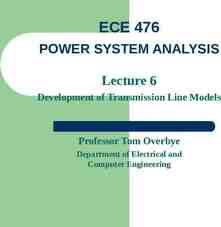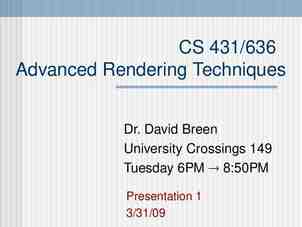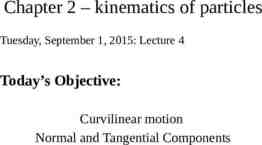CS 548 – Spring 2016 Sequence Mining Showcase by: Daniel
15 Slides2.02 MB

CS 548 – Spring 2016 Sequence Mining Showcase by: Daniel Duhaney, Scott Judson, Michaela Kachadoorian Showcasing work of: Daniel Schweizer, Michael Zehnder, Holger Wache, Hans-Friedrich Witschel, Danilo Zanatta, Miguel Rodriguez on “Using consumer behavior data to reduce energy consumption in smart homes”

References 1. Daniel Schweizer, Michael Zehnder, Holger Wache, Hans-Friedrich Witschel, et al. “Using consumer behavior data to reduce energy consumption in smart homes.” In 2015 IEEE 14th International Conference on Machine Learning and Applications (ICMLA), pp. 11231129. IEEE, 2015. 2. King, N. “Smart home. A definition” Intertek Research and Testing Center, pp. 1-6, 2003. 3. C. Baumann. "Smart energy case study." In Proceedings of the Fourth ACM Workshop on Embedded Sensing Systems for Energy-Efficiency in Buildings, pp. 36-38. ACM, 2012. 4. D. Schweizer. "Learning frequent and periodic usage patterns in smart homes.“ Master’s thesis, School of Business, University of Applied Sciences and Arts Nortwestern Switzerland (FHNW) Feb, 2014 https:// www.digitalstrom.org/wp-content/uploads/2014/01/Daniel Schweizer-2014-Learning freq uent and periodic usage patterns in smart homes Final.pdf 5. M. Zehnder. "Energy saving in smart homes based on consumer behaviour data." Master’s thesis, School of Business, University of Applied Sciences and Arts Nortwestern Switzerland (FHNW) Jan, 2015.https:// www.digitalstrom.org/wp-content/uploads/2014/01/Michael-Zehnder-2015-Energy-savingin-smart-homes-based-on-consumer-behavior-data.pdf . 6. M Zehnder. "Energy saving in smart homes based on consumer behavior: A case study." In Smart Cities Conference (ISC2), 2015 IEEE First International, pp. 1-6. IEEE, 2015 http ://ieeexplore.ieee.org/xpl/login.jsp?tp & arnumber 7366231&url http%3A%2F%2Fieeexplore.ieee.org%2Fxpls%2Fabs all.jsp%3F arnumber%3D7366231 7. Nizar R. Mabroukeh and C. I. Ezeife. “A taxonomy of sequential pattern mining algorithms.” ACM Comput. Surv. Vol. 43, No. 1, Article 3. DecemberWorcester 2010. Polytechnic Institute http://doi.acm.org/10.1145/1824795.1824798

Smart Home A “dwelling incorporating a communications network that connects the key electrical appliances and services, and allows them to be remotely controlled, monitored or accessed” [1]. One of the major benefits of a smart home is the ability to maximize the efficiency of energy consumption. Worcester Polytechnic Institute

http://domotica-winkel.nl/media/catalog/product/cache/1/image/512x512/9df78eab33525d08d6e5fb8d27136e 95/d/i/digitalstrom.apps and the connected home 2 2 3 1.jpg Worcester Polytechnic Institute

Sequence mining consumer behavior to improve energy conservation M. Zehnder, et al. "Energy saving in smart homes based on consumer behaviour data." PhD diss., Master’s thesis, School of Business, University of Applied Sciences and Arts Nortwestern Switzerland (FHNW) Jan, 2015. Worcester Polytechnic Institute

Training data set Previous data collected between 12/8/02-6/25/14 33 homes 3521 devices in the 33 homes 4,331,443 total events in all 33 homes 6829 unique events or scenes 5 1 3 Events 5 1 3 One Pattern Worcester Polytechnic Institute

Algorithm Criteria Find both frequent sequential patterns and periodic sequential patterns Find wildcarded patterns and output where the wildcard is positioned in the pattern Process the continuous stream of data coming from a smart home (process events in real time) Worcester Polytechnic Institute

Window Sliding with De-Duplication (WSDD) Window size 5 events 2002 2014 Adapted from Figure 8: The difference between overlapping and non-overlapping patterns by D. Schweizer, et al. "Learning frequent and periodic usage patterns in smart homes." Worcester Polytechnic Institute

Window Sliding with De-Duplication (WSDD) Brute Force Method Loop 1: Build possible patterns Loop 2: Count the support Improved brute force method using hash tree & post-pruning HashMap-Keys HashMap-Values 513 0.14 128 0.21 278 0.19 Post-processing to eliminate infrequent patterns that do not constitute normal behavior Worcester Polytechnic Institute

WSDD basic pattern mining algorithm smartHomeList [sh0,sh1, shi] eventi {ev0,ev1, evj} where evij {startTime, endTime, sourceID, sceneID} minPatternLength, maxPatternLength, minSupportCount defined by user For each smartHome in smartHomeList download all of the events for sh sort events by startTime and eventID lastPosition number of events in database for smartHomeID for position for range(startPosition, lastPosition) for patternLength in range(minPatternLength, maxPatternLength patternk ev0 ev1 evcurrentLength hash(patternk): if hash(patternk) exists: increment supportCountk in hash tree else: supportCountk 1 in hash tree patternList for smartHome patterns where supportCount minSupportCount Worcester Polytechnic Institute

Algorithm Results Learning frequent and periodic usage patterns in smart homes Conclusion WSDD is a competitive algorithm when compared to other sequential pattern mining algorithms WSDD has good run times due to relatively small number of different patterns in a smart home Wildcarding is not necessary for smart home event datasets Figure 2. Benchmark of run times for data mining algorithms FIGURE 61: ADJ USTED RUN TIME BENCHMARK FOR MINSUP 0.005, OVERLAP TRUE, LENGTH 2-5 As can be seen, WSDD is the best choice regarding run times with those settings. This corresponds with D. Schweizer, et al. "Using consumer behavior data to reduce energy consumption in all the other benchmarks conducted for this research project and from a runWorcester time point of view it can smart homes." arXiv preprint arXiv:1510.00165 (2015).[To be presented at IEEE Polytechnic Institute International of Machine and Applications (ICMLA,like Dec. 2015) thereforeConference be concluded that Learning using elaborate algorithms PrefixSpan or GapBIDE is not only an

The architecture of the recommender system developed in this project (illustrated in Figure 26) can be divided in tree main parts: The storage of the association rules. Recommender System The event stream of the current behaviour data inside the smart home. The matching algorithm for both previous points. Figure 26 Architecture of the recommender system The ruledatabasestores the association rules, which were deduced from the relevant pattern. Polytechnic Institute The event streamcontains the current events from the smart home, ordered byWorcester time of their occurrence. M. Zehnder, et al. "Energy saving in smart homes based on consumer behaviour data." PhD diss., Master’s thesis, School of Business, University of Applied Sciences and Arts Nortwestern Switzerland (FHNW) Jan, 2015.

Design of the recommender system Recommender-Finite State Machine Figure 27 Example for the state machine created froman association rule The example for the state machine in Figure 27 is for an association rule deduced from a pattern, where Worcester Polytechnic Institute the action was at the end of a pattern. Therefore, the last condition before sending the recommendation M. Zehnder, et al. "Energy saving in smart homes based on consumer behaviour data." PhD diss., Master’s thesis, School of Business, University of Applied Sciences and Arts Nortwestern Switzerland (FHNW) Jan, 2015.

(F S M ) h o u s e s a g re e d to in c lu d in g b o th R e c o m m e n d a tio n s th e in h a b ita n ts . A n in F ig . 5 . p a rtic ip a te in th e e v a lu a tio n o f th is w o rk s in g le - a n d m u lti-in h a b ita n t h o u s e s . w e r e s e n t p e r S M S to th e m o b ile d e v ic e s o f e x a m p le o f s u c h r e c o m m e n d a tio n is s h o w n Response to Recommendations c ia tio n r u le s , w h ic h p a t t e r n s . T h e ev en t o m th e s m a rt h o m e , re c o m p o n e n t o f th e r u le s a n d th e e v e n t m a tc h in g a lg o r ith m is r m in is tic f in ite s ta te F ig . 4 , w h ic h re fle c ts E . A n e w in s ta n c e o f th e s tre a m . If th e re is a n c e is re m o v e d fro m th e n e x t e v e n t is n o t m m e n d a tio n . e m a llo w s m o re th a n e . In o rd e r to a v o id w e p ro p o s e to w e ig h t z a tio n c r ite rio n . W e ra n th e e v a lu a tio n in tw o p h a s e s , w h ic h a re d e s c r ib e d in th e fo llo w in g s e c tio n s . T A B L E II. K E Y R E S U L T S O F E V A L U A T IO N P a r a m eter # d a y s e v a lu a te d P h a se 1 2 14 34 160 120 76 55 7 5 69 50 9 .2 1 % 9 .1 0 % N u m b e r o f a c tiv e ru le s 54 46 N u m b e r o f ru le s th a t re s u lte d in re c o m m e n d a tio n s 23 17 5 3 R e c o m m e n d a tio n s se n t A n s w e r e d r e c o m m e n d a tio n s V o te d u s e fu l V o te d n o t u s e fu l R a tio u s e fu l/a n s w e re d N u m b e r o f ru le s w ith 1 0 n e g a tiv e fe e d b a c k s A . P h a se 1 T h e a im o f th e firs t p h a s e w a s to p r o v id e a la r g e b a s is o f d a ta fo r e v a lu a tio n a n d fu rth e r im p ro v e m e n t o f th e s y s te m . T h homes e a n abased l y s i on s oconsumer f t h e dbehaviour a t a c o data." l l e c t PhD e d diss., d u r Master’s i n g p h thesis, a s e School 1 s h oofu l d Worcester h e lp Polytechnic Institute M. Zehnder, et al. "Energy saving in smart fro m th e lo g file s o f Business, University of Applied Sciences and Arts Nortwestern Switzerland (FHNW) Jan, 2015. to im p ro v e th e re c o m m e n d e r s y s te m in te r m s o f d e c re a s in g th e e m e n te d o n a c lo u d a c h in e ). T h e V M w a s

Questions?






